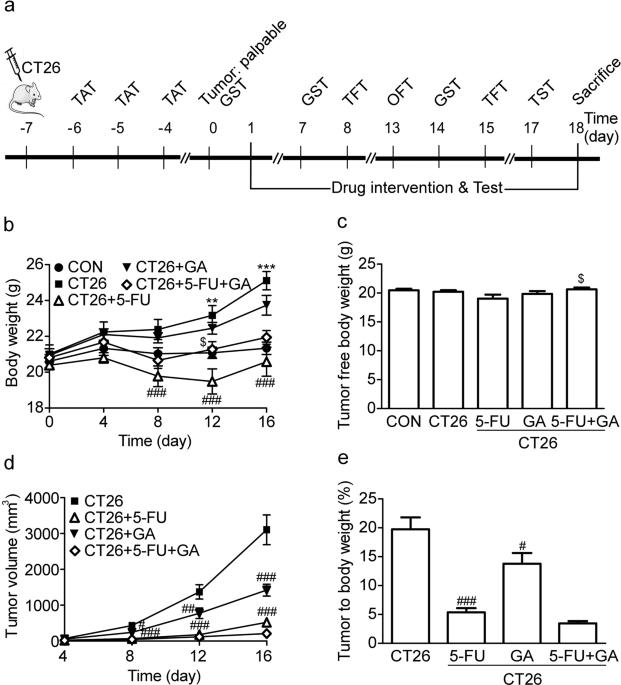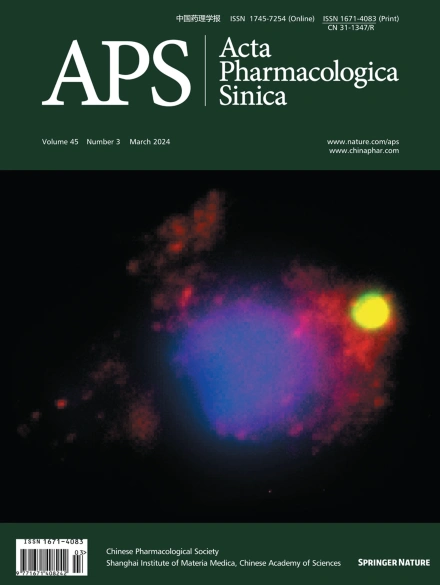灵芝酸可减轻结肠肿瘤小鼠化疗引起的疲劳
IF 6.9
1区 医学
Q1 CHEMISTRY, MULTIDISCIPLINARY
引用次数: 10
摘要
化疗相关疲劳(CRF)越来越被认为是化疗患者的严重症状之一,它不仅在很大程度上降低了患者的生活质量,还削弱了患者的身体和社会功能。目前,还没有预防和治疗 CRF 的有效药物。从传统中药灵芝中分离出的灵芝酸(Ganoderic Acid,GA)具有抗肿瘤、抗炎、免疫调节等多种药理活性。在本研究中,我们探讨了GA是否具有抗CRF疲劳的活性。CT26肿瘤小鼠接受5-氟尿嘧啶(5-FU,30毫克/千克)和GA(50毫克/千克)单独或联合治疗18天。对小鼠的外周和中枢疲劳相关行为、能量代谢和炎症因子进行了评估。我们发现,通过改善肌肉质量和线粒体功能、增加糖原含量和 ATP 产出、降低乳酸含量和 LDH 活性以及抑制骨骼肌中 p-AMPK、IL-6 和 TNF-α 的表达,联合应用 GA 可改善 5-FU 诱导的外周肌肉疲劳样行为。通过抑制TLR4/Myd88/NF-κB途径,GA还能下调海马中IL-6、iNOS和COX2的表达,从而延缓5-FU诱导的中枢疲劳样行为。这些结果表明,GA能减轻5-FU诱导的肿瘤小鼠外周和中枢疲劳,这为GA在临床上作为治疗CRF的潜在药物提供了证据。本文章由计算机程序翻译,如有差异,请以英文原文为准。

Ganoderic acid alleviates chemotherapy-induced fatigue in mice bearing colon tumor
Chemotherapy-related fatigue (CRF) is increasingly being recognized as one of the severe symptoms in patients undergoing chemotherapy, which not only largely reduces the quality of life in patients, but also diminishes their physical and social function. At present, there is no effective drug for preventing and treating CRF. Ganoderic acid (GA), isolated from traditional Chinese medicine Ganoderma lucidum, has shown a variety of pharmacological activities such as anti-tumor, anti-inflammation, immunoregulation, etc. In this study, we investigated whether GA possessed anti-fatigue activity against CRF. CT26 tumor-bearing mice were treated with 5-fluorouracil (5-FU, 30 mg/kg) and GA (50 mg/kg) alone or in combination for 18 days. Peripheral and central fatigue-related behaviors, energy metabolism and inflammatory factors were assessed. We demonstrated that co-administration of GA ameliorated 5-FU-induced peripheral muscle fatigue-like behavior via improving muscle quality and mitochondria function, increasing glycogen content and ATP production, reducing lactic acid content and LDH activity, and inhibiting p-AMPK, IL-6 and TNF-α expression in skeletal muscle. Co-administration of GA also retarded the 5-FU-induced central fatigue-like behavior accompanied by down-regulating the expression of IL-6, iNOS and COX2 in the hippocampus through inhibiting TLR4/Myd88/NF-κB pathway. These results suggest that GA could attenuate 5-FU-induced peripheral and central fatigue in tumor-bearing mice, which provides evidence for GA as a potential drug for treatment of CRF in clinic.
求助全文
通过发布文献求助,成功后即可免费获取论文全文。
去求助
来源期刊

Acta Pharmacologica Sinica
医学-化学综合
CiteScore
15.10
自引率
2.40%
发文量
4365
审稿时长
2 months
期刊介绍:
APS (Acta Pharmacologica Sinica) welcomes submissions from diverse areas of pharmacology and the life sciences. While we encourage contributions across a broad spectrum, topics of particular interest include, but are not limited to: anticancer pharmacology, cardiovascular and pulmonary pharmacology, clinical pharmacology, drug discovery, gastrointestinal and hepatic pharmacology, genitourinary, renal, and endocrine pharmacology, immunopharmacology and inflammation, molecular and cellular pharmacology, neuropharmacology, pharmaceutics, and pharmacokinetics. Join us in sharing your research and insights in pharmacology and the life sciences.
 求助内容:
求助内容: 应助结果提醒方式:
应助结果提醒方式:


